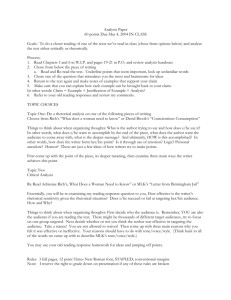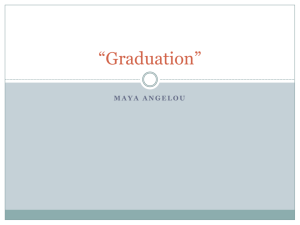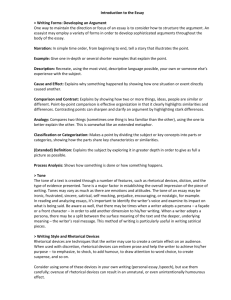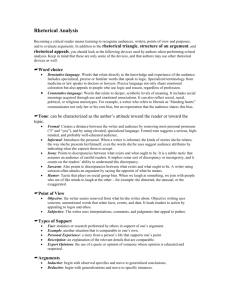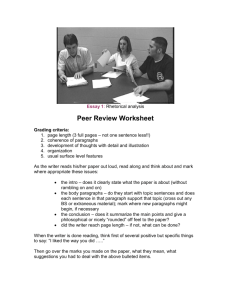Review of Rhetoric
advertisement
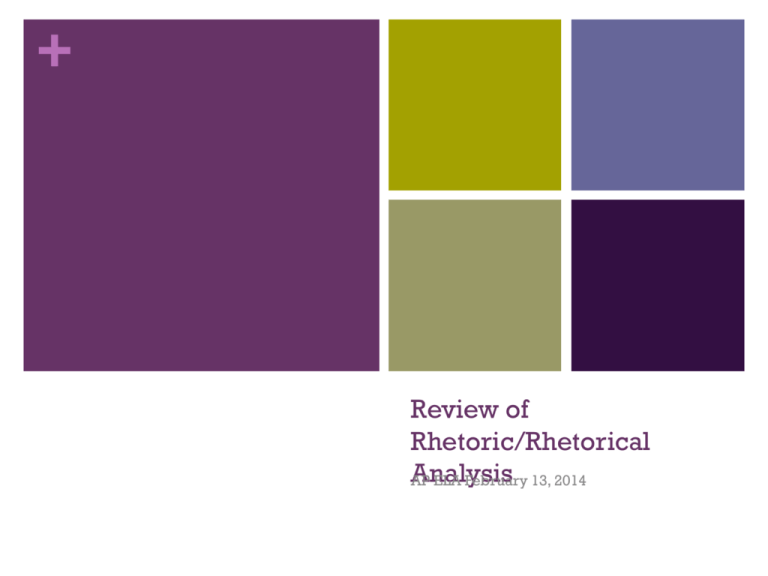
+ Review of Rhetoric/Rhetorical Analysis AP ELA February 13, 2014 + Bellrigner Identify the theme of the following paragraph: The Bundle of Sticks An old monkey on the point of death summoned his sons around him to give them some parting advice. He ordered them to bring in a bundle of sticks, and said to his eldest son: "Break it." The son strained and strained, but with all his efforts was unable to break the sticks. The other sons also tried, but none of them was successful. "Untie the bundle," said the father, "and each of you take a stick." When they had done so, he called out to them: "Now, break," and each stick was easily broken. "You see my meaning," said their father. A. It is better to work alone then with others. B. There is strength in unity. C. Tasks become easier if you make them smaller. + ACT Prep + SOAPSTone S = Subject O = Occasion A = Audience P = Purpose S = Speaker Tone= yes + Rhetorical Strategies Appeals- What are they? Ethos Pathos Logos + Rhetorical Strategies Style Diction Syntax Details Imagery Tone Etc. + Syntax Syntax refers to how we arrange words to express thoughts. Note that a writer can choose innumerable ways to express the same thought via diction, detail, and arrangement: Example: I went to the store in the morning. In the morning, I went to the store. I drove to the store this morning. After sunrise, I went to the store. In the morning to the store I went. + Syntax From an AP standpoint, we want to pay careful attention to a writer’s syntax. A writer’s choice of word arrangement may contribute to the meaning. Consider the examples: I went to the store in the morning. To the store I went in the morning. In the morning to the store went I. The emphasis in each sentence shifts. The first emphasizes “I,” The second “store,” The third “morning.” In other words, the focus shifts from person to place to time. A writer can choose what element to emphasize by its placement in the sentence. The information is the same, but the emphasis differs— thereby potentially affecting the meaning in the context of the larger passage. + Syntax On the AP test, you cannot analyze every sentence. Instead, look for patterns that appear throughout the selection. Ask yourself: Might this pattern in some way contribute to the point the author makes? Also, look for “standout sentences”—that is, a sentence whose pattern or arrangement stands in marked contrast to the surrounding ones. + Syntax The following terms and concepts pertaining to sentence structure are essential in preparing for the AP English exams: Antithesis Ellipsis Inversion (or inverted sentence) Juxtaposition Parallelism Repetition (using repetitive sentence structures or elements for effect) Rhetorical Question Rhetorical Fragment Provide a definition for each term in your notebooks. + Rhetorical Analysis Here are the questions that you need to ask in order to analyze a piece of writing: Why did the author choose these strategies for the particular audience, occasion, and/or purpose? i. HOW do the rhetorical strategies help the author achieve his/her purpose? ii. WHY does the author chose those strategies for that particular audience and for that particular occasion? + RA Essay There are many ways to write an effective rhetorical analysis essay.. You may find as you become more comfortable with analysis that you want to deviate from this format. That’s fine as long as you are still focusing on: 1. SOAPSTone 2. Appeals/Style 3. Questions + Intro paragraph- RA Essay The introductory paragraph to an analysis essay is usually brief. However, it must contain some essential information. Put SOAPS in your introduction and follow this format: FORMAT: 1. Speaker, Occasion, and Subject (Writer’s credentials), (writer’s first and last name), in his/her (type of text), (title of text), (strong verb – see list)(writer’s subject). Well-known essayist and writer, Joan Didion, in her essay, The Santa Ana, describes the dramatic mood altering effects of the Santa Ana winds on human behavior. 2. Purpose (Writer’s last name)’s purpose is to (what the writer does in the text). Didion’s purpose is to impress upon readers the idea that the winds themselves change the way people act and react. + Intro Paragraph – RA Essay 3. Audience He/she adopts a[n] (adjective describing the attitude/feeling conveyed by the writer) tone in order to (verb phrase describing what the writer wants readers to do/think) in his/her (intended audience). She creates a dramatic tone in order to convey to her readers the idea that the winds are sinister and their effects inescapable. + Example Identify the parts of SOAPSTone in your notebooks. Novelist, Amy Tan, in her narrative essay, “Fish Cheeks,” recounts an embarrassing Christmas Eve dinner when she was 14 years old. Tan’s purpose is to convey the idea that, at fourteen, she wasn’t able to recognize the love her mother had for her or the sacrifices she made. She adopts a sentimental tone in order to appeal to similar feelings and experiences in her adult readers. + Body paragraphs – RA Essay This is the analysis part! Include a detailed explanation of strategies used by the writer. When writing an analysis, it is crucial that you work chronologically through the text. You can discuss each paragraph (one at a time)or divide the text into sections (beginning, middle, end). – This is dependent on text length. Transition words to use to move through the text: Begins, opens, closes, contrasts, shifts to, juxtaposes, ends, moves to + Body Paragraphs Every analysis paragraph MUST: Identify the part of the text you are analyzing by using transition words and strong verbs to explain what is being said. Identify the strongest rhetorical strategies used in that particular section. This includes incorporating specific text examples (exact words from the text – see last page of this handout for proper format) into your own words. Do NOT try to discuss every strategy the writer uses; pick the strongest! Clearly and specifically explain how the rhetorical strategies are used to help the writer achieve his purpose and reach his audience. The above items must be woven together seamlessly into one sophisticated paragraph of the body of your analysis essay + Body Format The first sentence identifies which section of the text you are discussing and the main idea of that section. (Writer’s last name) (transition word) his/her (type of text) by (strong verb) that (main idea of this section of the text). The second sentence conveys the writer’s support for the main idea by identifying and providing a specific example for one rhetorical strategy used by the writer. [This sentence is repeated if you want to discuss more than one rhetorical strategy.] + Body Format The third sentence explains how the rhetorical strategies you discussed in the previous sentences help the writer achieve his purpose by using an in order to statement. He joins in this time of mourning in order to unify the nation and humbly admit that “we share this pain with all of the people of our country” (4). The fourth sentence identifies the effect of the writer’s use of these rhetorical strategies on the audience. + Example Reagan begins his tribute to the Challenger astronauts by acknowledging that the shuttle accident has appropriately postponed his planned State of the Union address and by expressing the depth of his and his wife’s personal grief. He appeals to the mournful emotions of the audience by admitting that he and Nancy are “pained to the core” (3), that today is rightfully a “day for mourning and remembering” (2-3), and that the accident is “truly a national loss” (4). He joins in this time of mourning in order to unify the nation and humbly admit that “we share this pain with all of the people of our country” (4). This outpouring of emotion from the president conveys a calming tone that reassures the Nation that their grief is both understandable and proper. + Conclusion The conclusion is probably the easiest part. Be brief. In onetwo sentences, simply remind your reader of the things you said in the introduction + Handouts KEEP IN YOUR BINDER FOR THE LOVE OF EVEYRTHING HOLY AND GOOD! + Reading Read Virginia Woolf “Professions for Women” on page 356. Answer the following questions in your notebooks. 1, 3, 5, - Questions for discussion 1, 2, 3, 5, 6, 10, 11, 12- Questions for Rhetoric and Style
